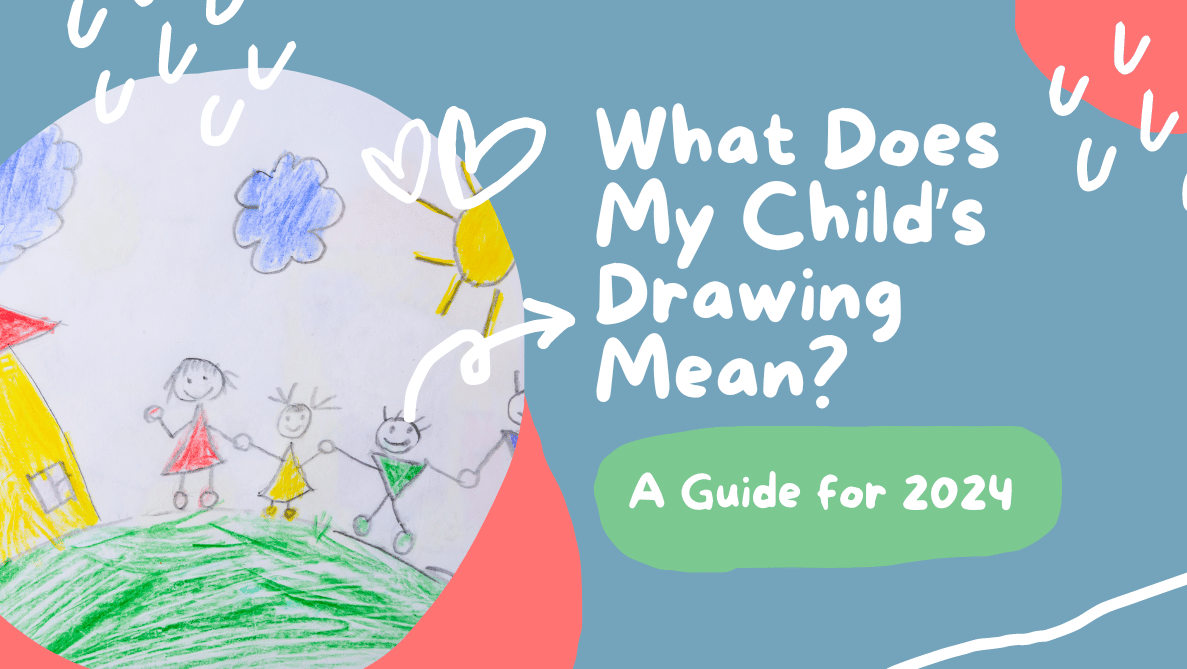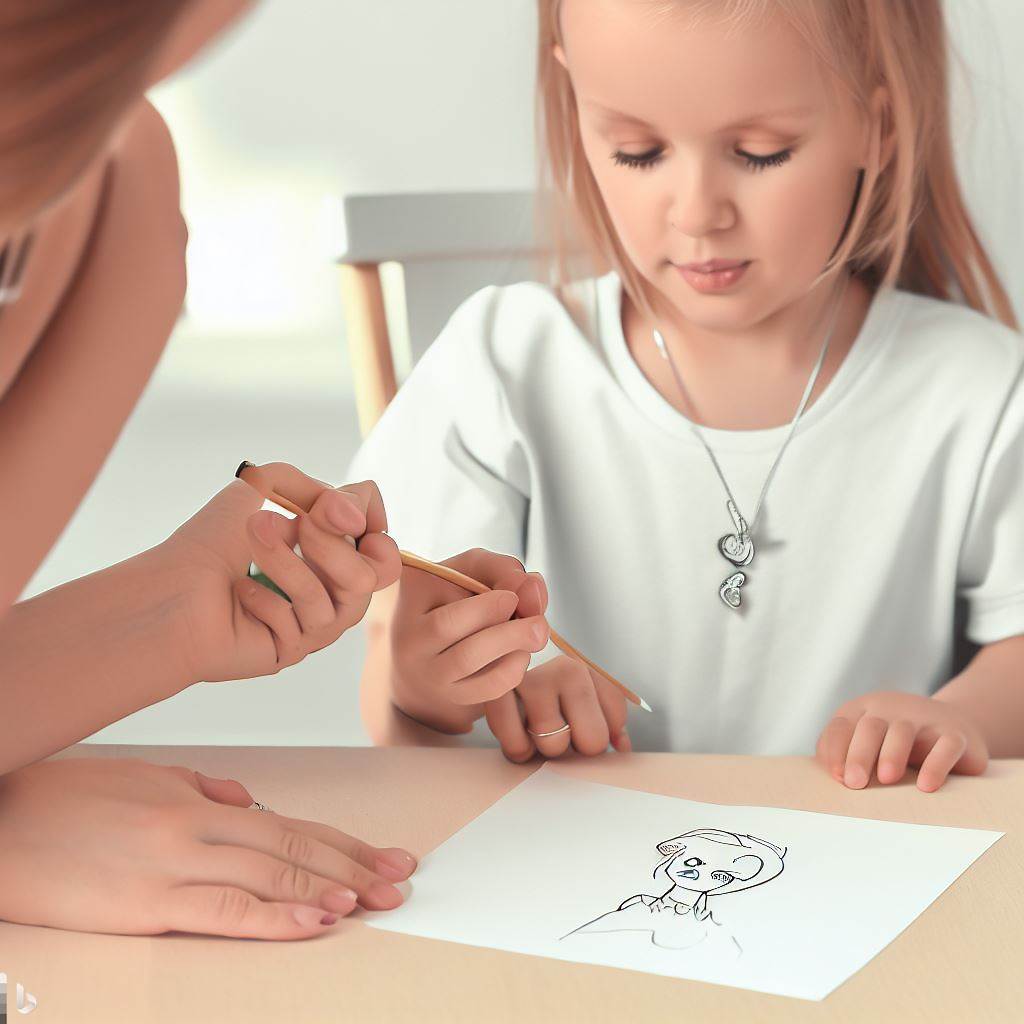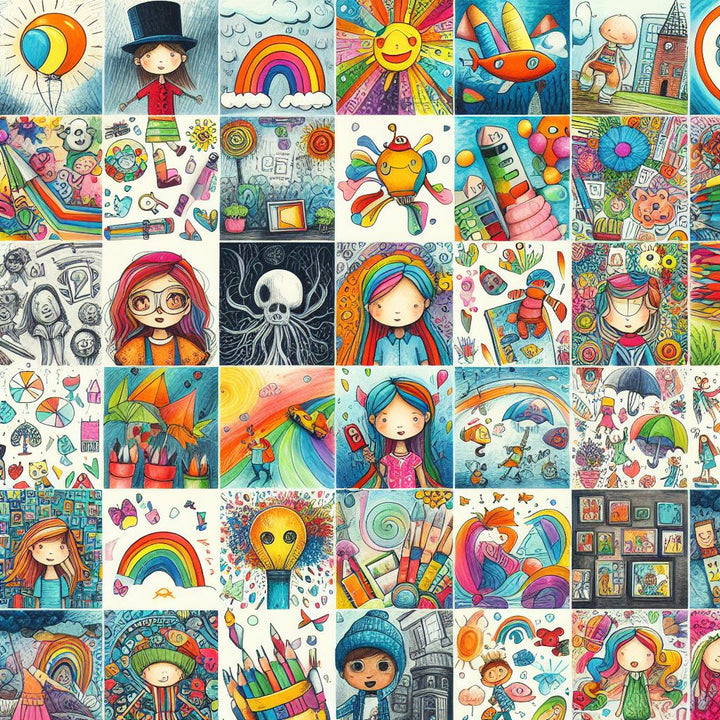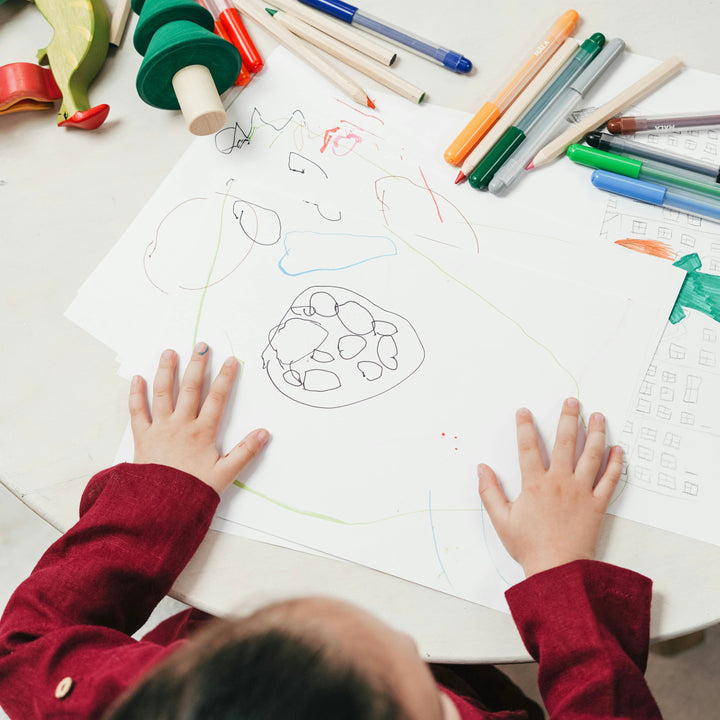In this article, I am exploring the topic of 'What Does My Child's Drawing Mean?'
By reading this blog post, you will find answers to the most common FAQs about children's drawings and what they could mean.
You will also find a guide for reviewing and analyzing your kid's artwork by looking at colors, subjects, size, patterns and more.
If you are interested in the topic of children's drawings, make sure you also check my other article:
Can't wait to learn more? Let's dive into this post then!
What Does My Child's Drawing Mean: General FAQ
What is Drawing?
Drawing is the act of using an instrument to mark a flat surface such as paper. The most common drawing instruments are pencils, pens, and crayons.
What is a Child's Drawing?
A child's drawing is a very simple artwork, made by a child at home or school. It's generally characterized by the absence of realistic details.
Why Is It Important to Understand Children's Drawings?
Understanding children's drawings and their meaning is important for determining whether the drawing is appropriate to the corresponding age of the child.
Understanding why the child chose to draw in a given manner – in terms of drawing tools, choice of objects, their spatial distribution on the page – why he chose these particular colors, etc. can provide a broad personality profile covering the child's performance in various areas in his life.
It is also very important for understanding feelings and emotions that a child might bear and at the same time he is not able to express in words.
How to Encourage Your Child to Draw?
There are a number of ways to encourage your child to draw. You can:
- Show encouragement and support by displaying your child's drawings
- Make drawing an integral and regular part of playtime
- Help them develop their drawing skills (but pay attention not to ask them to write subjects that are too advanced for their drawing stage)
What Are the Main Drawing Stages?
There are three stages of children drawings:
- Scribbling
- Pre-Schematic
- Schematic
Scribbling (2-4 Years)
The Scribbling stage is characterized by a lack of realism. Children at this stage mostly make marks on the page, although it is sometimes possible for shapes to resemble real objects such as a car or house.
Pre-Schematic (4-7 Years)
During the Pre-Schematic stage, children try to replicate things they see with their eyes. They might draw faces, stick figures, cars, trucks, trees, and houses.
This stage also lacks of realistic details. However, towards the end of the stage children are likely to add original details such as flowers in front of a house or clothes on the stick figures.
Schematic (+7 Years)
In the Schematic stage there is some evidence of logic. For example, a drawing of the ocean might include sea gulls, starfish, a beach ball, people wearing bathing suits, etc.
Some children might also add words and symbols to give further messages of explaining the drawing.
In general, in this stage the drawings will have more depth and realism.
Bonus: the Realistic or Gang Stage (+9 Years)
Some authors include a fourth development stage for children drawing: the Realistic or Gang stage (source: healthofchildren.com):
Here, the child begins to develop more detail in drawing people and in determining perspective (depth or distance) in drawings. Shapes now have form with shadows and shading. The people they draw show varying expressions. Colors are used to accurately depict the environment, and more complex art materials may be introduced.
Does Drawing Always Mean Something?
Drawing doesn't always and necessarily mean something good or bad.
Sometimes it's just the way children express their creativity and should not be over-analyzed.
What If My Child Doesn't Like to Draw?
As mentioned before, drawing is just a way of expressing the child's creativity.
Some children don't particularly enjoy drawing and find different ways to express their creativity.
Having said that, fine motor skills are clearly a prerequisite for drawing, but not all children who refuse to draw suffer from a motor problem. Many of them dislike drawing because they clearly prefer gross motor activities – they will draw, write and also do homework in the future, but will tend to do so quickly and move on.
Another reason for stopping to draw may have to do with an intervention experience that has obstructed the natural process of drawing development.
For example, when the child is still in the scribbling stage, one family member starts teaching him how to draw forms and figures – this kind of learning actually requires a developmental "leap" to a more advance stage, and such an intervention could cause the child to give up on drawing altogether.
Other causes can be too many admonitions that have to do with orderliness and cleanliness, that spoil the creative atmosphere, inappropriate artistic criticism by adults and other children (particularly older brothers).
When to Examine the Drawing?
Since drawings can have more than one meaning, it's important to pay attention to to but never over-analyze the artwork (source: ABClearningcenterfl.com):
Talking to your child about their drawings, and asking them about why they included certain details provides insight and can help bat off unnecessary worries. Just make sure to keep your dialogue open-ended so that your child has a chance to explain for themselves what they have drawn and why.
In general, the first impression is always a good indicator of whether examining your kid's drawing or not.
Focus on how looking at the drawing makes you feel.
Does your kid's art make you feel happy or sad? Does it make you feel disturbed?
If the feeling you get from your first impression is not a positive one, this is probably the most important clue leading to the analysis of the drawing.
Some situations, where is recommended to analyze a child's drawings are when (source: parenting.firstcry.com):
- The child is drawing violent pictures repeatedly
- The child draws a person or an object significantly bigger than himself
- The child draws disjointed body parts for human figures
- He uses too many dark colors and unpleasant images
What Does My Child's Drawing Mean: How to Decode the Drawings
Children's drawings can be analyzed in a number of ways, by looking at:
- Colors
- Subjects
- Gender
- Position
- Size
- Patterns
- Completeness
Each of these aspects can tell you a bit more about your child's mind and feelings.
Colors

Along with subjects, colors are probably one of the main features of a child's drawing that stand out.
There are two main questions to ask concerning colors:
- What Colors Does My Child Use?
- Why Does My Child Always Use a Certain Color?
There are three main things to keep in mind in answering these two questions:
- The meanings of colors are multiple and diverse. With older children, you can simply ask what qualities they like in each to gain a glimpse of their inner world
- Excessive use of a certain color should, in most cases, be interpreted in terms of the negative emotional qualities of that color
- Balanced use of a certain color usually indicates its positive emotional qualities
What Colors Does My Child Use?
According to color psychology, colors in children's drawings can tell about the child's state of mind, emotions and feelings that otherwise they would not be able to express verbally.
The general rule here is that the use of a variety of colors is always a good sign, while the predominance of a particular color is something worth to take a look at.
In general, bright colors show the calmness and inner peace, and kids are connected to their emotions. On the other hand, the intensive and turbulent colors, e.g. redden a shape previously was yellowing, represent internal conflict and distress (source: Colors.dopely.top).
The following are the main colors used by children in their drawings:
- Red
- Pink
- Green
- Yellow
- Purple
- Black
- Blue
- Brown
- Orange
- White
- Grey
Red
This is one of the most favorite colors among both girls and boys. It is the color of the blood in our veins and as such, it connotes enthusiasm and energy. Children who use it consistently are usually dominant and extroverted, and like to be at the center of attention. These kids like challenges and competitions and want to be winners. Excessive use of this color is common among aggressive children.
Pink
Pink indicates peace, balance, and emotion. Children who like to live in imaginary worlds use this, and no matter if they are boys or girls. It is the color of imagination. A frequent use of this color might hint at a child’s need to escape reality.
Green
Green is a favorite among nature-lovers, who like animals and outdoor play. It is commonly used by children who have a different and fresh outlook on situations, who are quick learners and need freedom and space. On the other hand, using this color too much can be a sign of separation anxiety disorder or high dependence.
Yellow
Yellow is often associated with joy, happiness, optimism, sociability, hope, and energy. A normal use of yellow comes from a happy and lively child, while using it too much frequently shows tensions in the environment or problems with authority.
Purple
The combination of red and blue is generally associated with conflict and homogeneous tendencies. The predominance of this color is often linked to melancholy and dissatisfaction.
Black
The researchers have mixed opinions here. For some this color shows anxiety, sadness, and hopelessness in a child. For others it’s linked to self-esteem and self-confidence. However, both school of thought believe that a very dark painting is generally to be considered as a warning sign.
It's important to notice that using the color black doesn't necessarily mean that your child is depressed.
The use of colors in children's drawings indicates only to some extent their mental state or mood.
Sometimes children use black only because it is available and many children like black because it creates a strong contrast with the white page.
Blue
Blue signifies calm and peaceful behavior. "Blue" children are characterized by peaceful and harmonious social relations and their communication with others is pleasant and calm. They demand rational explanations and refuse to hear answers such as "cause I told you so". They have a rich inner world, but it is important for them to express their wishes and desires.
Brown
Brown is the color of responsibility generally used by reasonable and cautious children. An excessive use of brown in a drawing sometimes points at the child being overwhelmed by not age-appropriate responsibilities.
Orange
Orange is often linked with pleasure and activity as well as the desire for progress or a child who needs contact with people. Using orange excessively might flag the risk for aggression and irritability.
White
While every drawing has an element of blank or empty space, an excessive use of white hints at emotional vacuum, and inability to express emotions, which sometimes can lead to antisocial tendencies.
Grey
Similarly to the white color, this one also shows the inability to express emotions.
Subjects
Similarly to colors, the subject of your child's drawings can have a symbolic meaning according to child psychology.
Children have an infinite amount of creativity and their can draw a huge variety of subjects.
Having said that, there are a number of subjects that are most commonly drawn by kids:
- Self-portrait (and other humans)
- Family
- House
- Tree
- Sun
- Clouds and rain
- Worrying or inappropriate drawings
Self-portrait (and other humans)
When using the word 'humans' in this context, I am referring to the so-called 'stick-figures' that children like to draw at different stages of their drawing development.
According to some, the way these stick-figures are drawn might have an implicit meaning (source: parent-smileandgrow.com):
Ears: their absence indicates little inclination to listen to others (never seen an ear on my daughter’s drawings, in fact..)
Mouth: its absence means that there is something that the child doesn’t want to say
Hands: When they are big, they represent going towards others, the relationship with other people
Arms or legs: Their absence indicates immaturity, still being totally dependent on the parents, or having not yet developed a distinct personality, separate from the mother’s
Some other things to be on the lookout for are a sad expression in their face, which could hide some inner-conflict that is not resolved.
Another important details is checking if your child is shading some body parts darker than the rest of the body.
This could mean an altered perception of how they see themselves.
Family

Family portraits are probably the most common drawing made by a child. As such, these artworks could be filled with hidden information about how your child feels and what he thinks.
Some general questions to find an answer for when looking at your kid's art are:
- Is every family member included in the portrait?
- Is the child depicted next to a family member or is he detached from the group?
- Who is the child standing next to in the drawing?
- Who is the biggest member of the family in the artwork?
- Is the family idle or are they doing an activity?
Some of the answers might not be obvious from the drawing. If that's the case, asking your child to explain some elements of his artwork could be very beneficial.
Based on the answers to the questions above, the following is generally accepted as true in child psychology:
- A missing family member might hint at conflict between him / her and the child
- If the child is drawn as detached from the group, this could mean that the kid lives in a chaotic environment
- The child is generally standing next to the family member he feels the closest to
- Size is generally used by children to indicate the importance of the family member (the general agreement is that the biggest in size is the leader of the family)
- If the family is working together to complete an activity, this is the sign that there is a good team work spirit at home
Another aspect to take into account is whether the depicted family members are smiling or bear an angry face.
A child depicting angry adults, especially if family members, might be experiencing an emotional trauma and it's something definitely worth investigating.
House
Houses are one of the first things that children draw.
The general agreement about child psychologists is that houses can be a representation of how children see their family life.
In this context, one of the main things to look out for is the the number of windows or their absence.
A house with a high number of windows might be a hidden message from the child wishing others could see what is happening at home.
On the other hand, the absence of windows might point at difficulty in being open or communicate.
Another very important detail is the door.
In children's house drawings, the door may have many meanings, but it chiefly signifies the entrance, or in emotional terms, the gateway to the child's inner world.
In other words, various ways of drawing the door can indicate the child's degree of emotional accessibility or openness to emotional dialogue with others:
- Is the child willing to be exposed? How much?
- How emotionally available is he right now?
- What defense mechanisms is he using to avoid exposure?
- And even – What is the best way to hold an emotional dialogue with him?
The drawing has many parts. If the child focuses and spends a long time on drawing a certain part, this means he devotes particular emotional attention to it.
Studies found that when children linger on the door area they are preoccupied (around the time the drawing is made) with the emotional meanings it signifies, including issues such as exposure, interacting with others, and access to one's intimate world.
Smaller elements in the door area Elements such as locks or peepholes also deserve particular attention, particularly in terms of their drawing style.
Generally speaking, the more standard details a drawn house has, the more likely the chance the child's home environment is peaceful and happy.
Also the more the details, like for example a chimney, flowers or a road, the more the feeling of serenity and happiness.
Tree
The tree is another classic element used in child psychology to assess the mental well-being of a child.
According to most, the tree can be interpreted as a visual representation of the bond with the child's deepest self (source: parent-smileandgrow.com):
When the trunk is well proportioned, with large branches, this translates into extroversion; while small branches conceal a fearful soul.
The roots indicate a solid family base; And the best of the best is the presence of leaves and fruits – whose predominance with respect to the trunk would indicate fantasy.
Sun
The sun is another classic element of children's drawing.
In the majority of cases, the sun is seen as a positive element, especially if drawn with a happy face or a smile and in the middle area of the paper.
On the contrary (source: sheknows.com):
A partial sun, often in the upper corner of a drawing, could indicate signs of anxiety regarding authority figures.
A sun barely peeking through a cloudy sky could indicate signs of depression and maybe even feelings of hopelessness in their situation.
Clouds and rain
It's widely accepted that the presence of clouds, especially if dark ones, and rain in a drawing might be a sign that your child is feeling a bit anxious about something.
This is particularly true if he draws himself next to or beneath clouds.
Worrying or inappropriate drawings
There are some cases in which it's obvious from your first impression that the drawing requires your attention.
It's when just by looking at the drawing you feel disturbed or sad.
Some of these drawings might not necessarily be a warning sign.
For example, a lot of children like to draw monsters. This doesn't mean there is something wrong with them. It could just be the result of a cartoon they watched on TV or Youtube.
In some other cases, the negative aspect of the drawing might be more striking.
I wrote before about how drawing angry people, especially if family members, might be a sign of the child experiencing an emotional trauma.
Unfortunately, even more serious is the case of children drawing inappropriate subjects or scenes of violence.
On the one hand, it's normal for children during their development phases to draw both inappropriate and violent scenes.
In general, they don't mean any harm as they are just trying to understand and figure things out for themselves.
As mentioned before, one single drawing is worth investigating but should not be cause for getting alarmed.
On the other hand, if you notice a number of inappropriate or violent drawings, it's probably the time to take things more seriously and investigate thoroughly by yourself or with the help of a qualified person.
Gender

There is really one main question here:
- Is there a difference in drawings between boys and girls? If so, what is it?
Generally speaking, both boys and girls tend to draw their own gender.
More specifically (source: novakdjokovicfoundation.org):
Girls usually draw rounded shapes, including flowers, hearts, while angles, boxes, and straighter lines are characteristics of boys, along with cars, buses, etc.
According to popular opinion, girls tend to use more colors than boys. They also tend to use warmer colors, while boys prefer cooler colors like blue, etc.
Other than this, there seems no significant difference between boys and girls when drawing.
Position
The position of the drawing on the page is a good indicator often revealing the child's mindset.
It's also important to bear in mind that this type of indicator needs to be applied to older children who have better motor skills.
According to popular opinion, the left side of the page is traditionally associated with the past and with nurturing, while the right side is linked with an interest in the future, and a need to communicate.
A child drawing on the left side of the page is a shy, introverted child; it could also mean the child is seeking the presence of a caring adult, or a nurturing mother- or father-figure.
A child drawing on the right, on the other hand, talks about someone who has a desire to communicate and is an out-going kid (source: parenting.firstcry.com).
Size
Size in kids' drawings is often associated with importance. The bigger the size of a person or object, the more important for the child.
Vice versa, the smaller the person / object, the less important for the child.
Patterns
It's normal for children's drawing patterns to change as they move through the development stages.
Having said that, a drastic change in their patterns is something worth investigating.
For example, if you notice your child moving from drawing houses, trees and family members to drawing weapons, violent scenes or sad faces, it's definitely worth having a conversation with him.
Completeness
A final element to take a look at when reviewing your child's drawings is their level of completeness.
Are the drawings left unfinished? Are the lines hesitantly drawn?
If that's the case, it might be a symptom that your child needs a bit of encouragement.
If you notice many corrections, this could also be a sign of some level of anxiety.
Conclusion
Children use drawing as a sort of second language.
By looking at your child's art you might be able to learn a great deal about your child's emotions, feelings and mental health in general.
When looking at the drawings, the first impression is very important. If you notice something that makes you feel sad or disturbed, it's no harm to talk with your child and ask questions about what they meant in the drawing.
Having said that, children have a huge imagination and it's very common for them to draw things without really understand their real meaning.
For this reason, it's important to look at various elements of the drawing including colors, position, size and patterns.
Finally, if you like your child's drawing and want to keep with you everywhere, you can check how we can turn children's art into a necklace, bracelet and keychain.
References
Drawings - stages, meaning, Definition, Description, Common problems. (n.d.).
The Psychology of Children’s Artwork. (2015, January 8). Childcare and Daycare Provider in Coral Springs | ABC Learning Center.
Clio. (2019, September 6). Keys to understand what your kids’ drawings really tell about them. Educazione Positiva per Genitori Che Vogliono Crescere Col Sorriso.
Fogarty, L., & Fogarty, L. (2018, July 19). SheKnows. SheKnows.
NDFAuthors. (2023, February 14). Learn to decode children’s drawings - Novak Djokovic Foundation. Novak Djokovic Foundation.
Forever Necklace or Keychain
$75.00 from $44.90 (deal of the day, until stock lasts)
 As parents we all receive an abundance of art and drawing pieces from our children. How about showing your child JUST how much you love their designs, by wearing their art - transformed into designer jewelry items - with pride Forever Drawn carefully turns your child's drawings into bespoke, handmade jewelry. Our custom necklaces, bracelets, and keychains are a wonderful memento of your child's creativity, imagination and love. Simply turn your children's art into jewelry. A token to keep with you always, or an amazing personalized gift for your mother or grandmother
As parents we all receive an abundance of art and drawing pieces from our children. How about showing your child JUST how much you love their designs, by wearing their art - transformed into designer jewelry items - with pride Forever Drawn carefully turns your child's drawings into bespoke, handmade jewelry. Our custom necklaces, bracelets, and keychains are a wonderful memento of your child's creativity, imagination and love. Simply turn your children's art into jewelry. A token to keep with you always, or an amazing personalized gift for your mother or grandmother






